The Silent Killer Called PM2.5
Air Date: Week of November 29, 2019
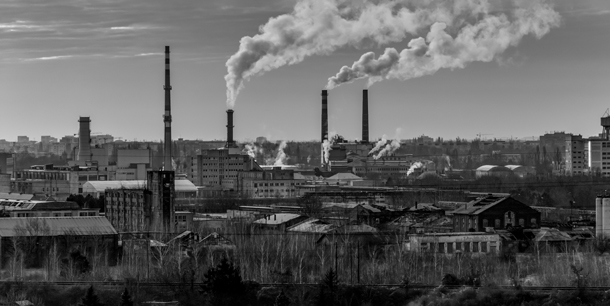
Industrial pollution in Bratislava, Slovakia. Smokestacks from coal-fired power plants and factories are a major source of PM 2.5 air pollution in middle- and low-income countries. (Photo: Dominik Dancs on Unsplash)
Ultra-fine particulate air pollution known as PM 2.5 is so small that it can work its way through the lungs into the bloodstream, and from there into major organs including the heart, brain, and kidneys. A new study published in the Journal of the American Medical Association, JAMA, finds a link between PM 2.5 air pollution at levels considered safe by the EPA and the deaths of 200,000 veterans over a recent decade. Earlier research linked PM2.5 with many disorders, including heart attacks and strokes, and this latest study adds three previously uncorrelated specific causes of death: dementia, kidney disease, and hypertension. Ziyad Al-Aly is a nephrologist and epidemiologist at Washington University School of Medicine in St. Louis and a coauthor of the study and joins Host Steve Curwood to discuss the findings.
Transcript
CURWOOD: From PRI and the Jennifer and Ted Stanley Studios at the University of Massachusetts Boston, this is Living on Earth. I’m Steve Curwood.
There’s more evidence that supposedly safe levels of air pollution can actually be deadly. According to a study recently published in a Journal of the American Medical Association 200,000 deaths of military veterans were linked to long term exposure to ultra fine particle pollution below EPA acceptable limits. Epidemiologists compared the records of 4.5 million veterans who died over a recent decade to levels of ultra fine particulates where they lived. These pollutants are called PM 2.5 for their size, which is two and half microns or about 30 times smaller than the width of a human hair, and almost all of us breathe them in every day, mostly thanks to the burning of coal and the tailpipes of millions of motor vehicles. Earlier studies have linked PM 2.5 pollution with a wide variety of maladies ranging from heart attacks and strokes to asthma and dementia. But now this research conducted at Washington University in Missouri has found associations with a total of nine disorders, including hypertension and kidney disease. Dr. Ziyad Al-Aly is a coauthor of the study and joins me now from St. Louis. Welcome to Living on Earth!
AL-ALY: Thank you very much for having me.
CURWOOD: So talk to me about what you found about the relationship between these fine particles found in pollution with disease and mortality.
AL-ALY: Sure. So we've known for a long time that PM 2.5, or ambient fine particulate matter air pollution is associated with all cause mortality, is associated with increased risk of death. And there have been a few causes of death that previously have been linked to ambient particulate matter air pollution, that's PM 2.5. But we didn't really know all the causes of death that were associated with PM 2.5 exposure. So we set out to define and characterize all the causes of death that are associated with exposure to high levels of PM 2.5. And we found in total nine. You know, several, as I said, have been characterized before, including deaths due to heart disease and deaths due to lung cancer and lung disease. But then a few are new, which include kidney disease, dementia, and deaths due to hypertension or elevated blood pressure.
CURWOOD: What was your resource for this study? How were you able to determine this?
AL-ALY: So we built a cohort of about 4.5 million participants from using a database at the VA, and then characterize the relationship between exposure to PM 2.5, and risk of death, all cause mortality, and ran risk of cause specific mortality, causes of death in core participants, and this is how we were able to, you know, figure out the causes of death associated with the PM 2.5 exposure.

Dr. Ziyad Al-Aly and his colleagues were able to find a correlation between PM 2.5 air pollution and hypertension, or high blood pressure, a previously unknown link. (Photo: Ryan Adams, http://homedust.com/, Flickr)
CURWOOD: Now over what period of time did you look at the exposure to the air pollution? Was it the week before they died, the two years before they died, how long?
AL-ALY: We were interested in more long term exposure to PM 2.5, and so we've taken annual exposure, sort of the average annual exposure to PM 2.5 throughout the duration of the study, which was more than 10 years.
CURWOOD: What's the level of exposure to fine particulates that we're talking about here? What are the numbers and what exactly is measured in that number?
AL-ALY: The numbers really vary. There are some people in the United States who are exposed to PM 2.5 of about five, and some about six and seven and eight, nine and 10 and 12 micrograms per meter cubed. So that's sort of a, it's a quantitative measure of evaluating the concentration of those particles in a volume of air.
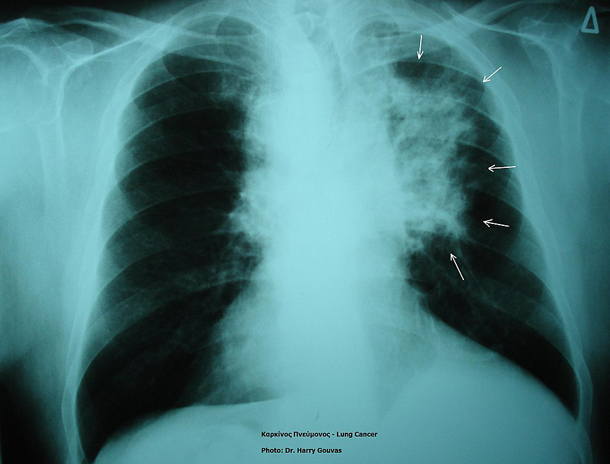
Lung cancer is also linked to PM 2.5 air pollution. (Photo: Δρ. Χαράλαμπος Γκούβας, Wikimedia Commons CC BY-SA 3.0)
CURWOOD: Okay.
AL-ALY: And obviously, the higher the worse, and the threshold that was set by the EPA is 12. So levels below 12 micrograms per meter cube now is considered from a regulatory perspective, considered safe.
CURWOOD: What does the World Health Organization say?
AL-ALY: The World Health Organization sets the level at 10 micrograms per meter cubed.
CURWOOD: So what's the mechanism of how these fine particulates cause illness and death?
AL-ALY: So when we breathe PM 2.5, it goes to our lungs, but because it is also so small, it permeates through the lung tissue into the bloodstream. And once it's in the blood, it circulates in the blood and then goes to other organs including the kidneys, the brain, the heart, the liver, the pancreas, where it may then affect them adversely.
CURWOOD: What parts of the country did you find a lot more mortality associated with PM 2.5, if there was any place?
AL-ALY: So it's really, the burden is not evenly distributed. You know, parts of the Midwest and parts of the South are more disproportionately affected.
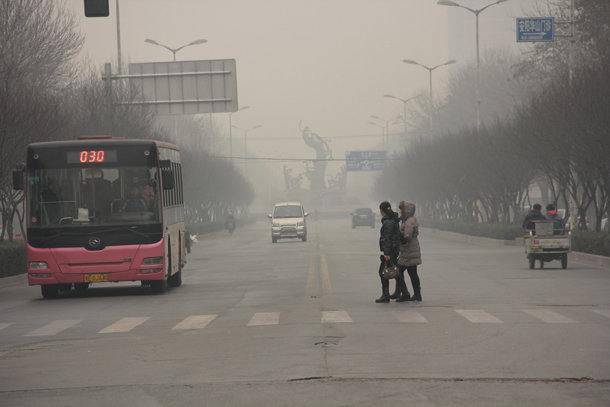
Air pollution in Anyang City, Henan Province, China, where coal-fired power plants and factories produce much of the PM2.5 air pollution. (Photo: V.T. Polywoda, Flickr CC BY-NC-ND 2.0)
CURWOOD: So it's interesting that one finding of your study is that even when exposed to comparably the same amount of fine particulate air pollution, that black patients, black veterans were more likely to die from this type of pollution than white patients. What do you think is going on there?
AL-ALY: Correct. This is really what was eye-opening, for the same exact level of PM 2.5, let's say for PM 2.5 equals 10 micrograms per meter cubed, for the same exact level of PM 2.5, black patients, black veterans exhibited higher risk. And when we adjusted or controlled or held constant, you know, socioeconomic deprivation, you know, still race, you know, exhibited what we call that statistically an interaction. What that really means that black people in our cohort were more vulnerable for the same level of PM 2.5 than white people, irrespective of their socioeconomic background. That could mean a lot of things. One of the potential explanations for this is that perhaps minorities may have less access to resources or health care or preventive measures, or a means to mitigate, you know, the adverse consequences of exposure to pollution. And as a result, they become more sensitive to it or more vulnerable to levels of PM 2.5. And geographically, black people tend to also to live in an area where there is high pollution. So not only do they live in areas that have a higher level of PM 2.5, or higher levels of pollution, but they're also more sensitive to it, or more vulnerable to it. And that's really almost like the odds are stacked significantly against racial minorities. And that's sort of a piece of environmental injustice.
CURWOOD: Now what are the major sources of fine particulates, PM 2.5, now in the US?
AL-ALY: So in the US it's primary land traffic, it's really cars on the roads. In other parts of the world, industrial emissions, including power plants that are burning coal, are really number one. And there are places in Southeast Asia and also in India, where biomass burning, when farmers would actually burn the remnants of their fields to try to get rid of the agricultural byproduct of producing rice and other things, and that also produces a huge amount of PM 2.5. But in the United States, the primary source of PM 2.5 island traffic, meaning cars on the road.
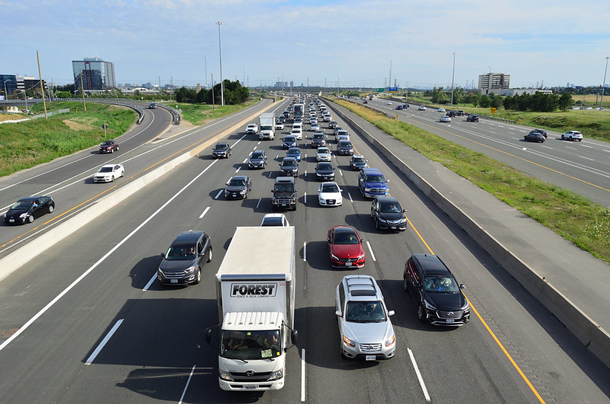
In the United States, cars and trucks are the largest source of fine particulate air pollution. (Photo: Open Grid Scheduler / Grid Engine, public domain)
CURWOOD: Now what about wildfires, to what extent do wildfires raise fine particulate levels as well?
AL-ALY: They do contribute to it, but wildfires tend to be in the United States only regional and primarily on the west coast. They're not really distributed throughout the nation, and also really seasonal in the sense that they, you know, happen only for like about a month per year. And then they produce spikes in PM 2.5, and that generally affects the yearly average, but not really, not really very dramatically. But they're certainly a source of PM 2.5 exposure that need to be considered in the discussion.
CURWOOD: One of the things that's startling about your research is that these deaths are linked to folks breathing air that the Environmental Protection Agency says is supposed to be safe.
AL-ALY: So yes, I mean, you can read this both ways. So when one of the ways that you could read this is that most of the deaths that we found are actually below the EPA recommended level of 12. So one way to read this is really enormous success of the EPA and the Clean Air Act in reducing PM 2.5 in the United States, and that, you know, most of the PM 2.5 in the US now is below 12, so most of the health consequences that you see are below 12. So our other reading of this is that oh, you know, like most of the deaths now are below 12. So maybe we should think about how do we, or what's the right threshold for us to try to, at the same time not really curb economic productivity or curb progress, you know, encourage progress, but while at the same time also reducing, you know, the health burden or the health consequences or mitigating those to the extent possible.
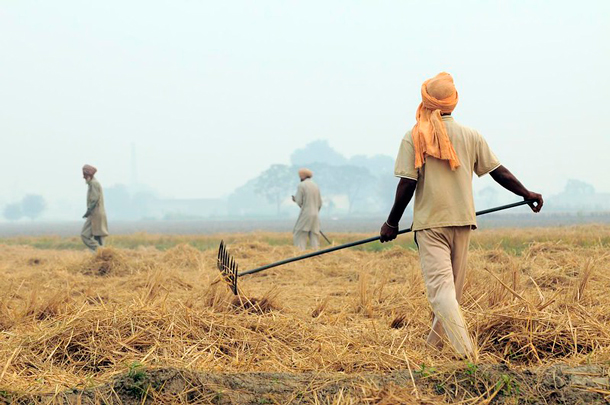
Farmers prepare to burn crop residues in harvested rice fields in Punjab, India, prior to the wheat season. Crop burning contributed to an air quality crisis in northern India in October and November of 2019. (Photo: Neil Palmer / CIAT, Flickr CC BY-SA 2.0)
CURWOOD: So, air pollution, of course, is hard to avoid, but to what extent is there anything that people can do to protect themselves? Let's start with here in the US.
AL-ALY: Well, when it comes to the individual level, it's really hard to sort of advise people on wearing masks; maybe when there is like wildfires like in Northern California and you know, about a month ago or so, and maybe wearing masks and trying to stay in door when the fire is raging, as a lot of you know, smoke outside, or a lot of PM 2.5 in the air. But short of that for like the average daily, you know, life of a person living in a major city or living in the suburbs or living in rural areas in the United States. I think there's not a whole lot a person can do other than really participate in the discussion. As, how do we as a society, try to, you know, work together to, you know, come up with ways of while at the same time encouraging economic productivity, curbing air pollution, to the extent possible to reduce the health impact of air pollution.
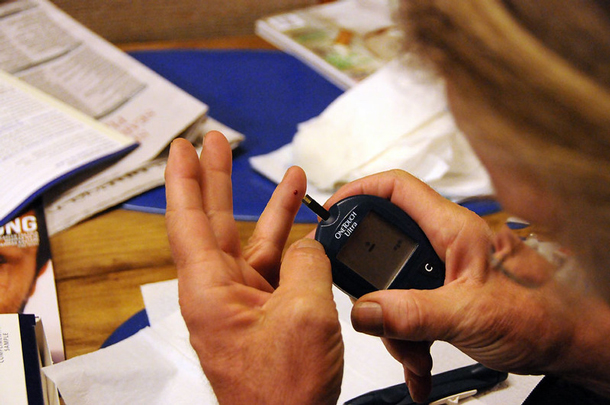
Fine particulate air pollution has been linked to an increased risk of developing Type II diabetes. (Photo: momboleum, Flickr CC BY-NC-ND 2.0)
CURWOOD: Dr. Ziyad Al-Aly of Washington University School of Medicine, thank you so much for taking your time with us today.
AL-ALY: Thanks a lot.
CURWOOD: And by the way, when there is a strong rainstorm it can briefly wash fine particulates out of the air, so if you notice a clean fresh smell after a rain storm you may in fact be breathing cleaner air.
Links
WIRED | “Air Pollution Is Still Killing Thousands of People in the US”
Read the journal article in JAMA, the Journal of the American Medical Association
Living on Earth wants to hear from you!
Living on Earth
62 Calef Highway, Suite 212
Lee, NH 03861
Telephone: 617-287-4121
E-mail: comments@loe.org
Newsletter [Click here]
Donate to Living on Earth!
Living on Earth is an independent media program and relies entirely on contributions from listeners and institutions supporting public service. Please donate now to preserve an independent environmental voice.
NewsletterLiving on Earth offers a weekly delivery of the show's rundown to your mailbox. Sign up for our newsletter today!
 Sailors For The Sea: Be the change you want to sea.
Sailors For The Sea: Be the change you want to sea.
 The Grantham Foundation for the Protection of the Environment: Committed to protecting and improving the health of the global environment.
The Grantham Foundation for the Protection of the Environment: Committed to protecting and improving the health of the global environment.
 Contribute to Living on Earth and receive, as our gift to you, an archival print of one of Mark Seth Lender's extraordinary wildlife photographs. Follow the link to see Mark's current collection of photographs.
Contribute to Living on Earth and receive, as our gift to you, an archival print of one of Mark Seth Lender's extraordinary wildlife photographs. Follow the link to see Mark's current collection of photographs.
 Buy a signed copy of Mark Seth Lender's book Smeagull the Seagull & support Living on Earth
Buy a signed copy of Mark Seth Lender's book Smeagull the Seagull & support Living on Earth

